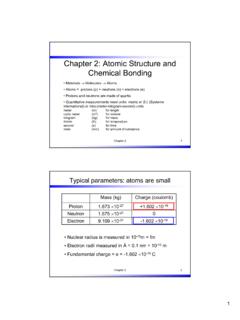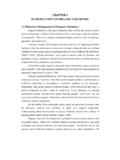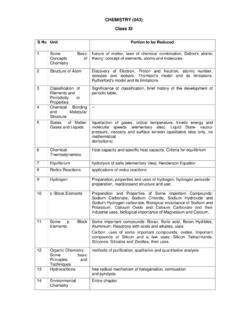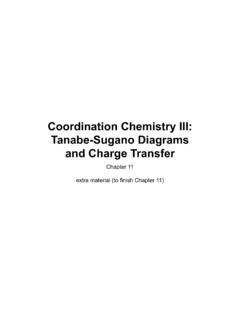Transcription of BASIC PRINCIPLES OF INORGANIC CHEMISTRY
1 BASIC PRINCIPLES OF INORGANIC CHEMISTRY Making the Connections RSC Paperbacks RSC Paperbacks are a series of inexpensive texts suitable for teachers and students and give a clear, readable introduction to selected topics in CHEMISTRY . They should also appeal to the general chemist. For further information on available titles contact Sales and Promotion Department, The Royal Society of CHEMISTRY , Thomas Graham House, The Science Park, Cambridge CB4 4WF, UK Telephone: +44 (0)1223 420066 Fax: + 44 (0)1223 423623 New Titles Available Archaeological CHEMISTRY by A. M. Pollard and C. Heron Food - The CHEMISTRY of Its Components (Third Edition) by T.
2 P. Coultnte The CHEMISTRY of Paper by J. C. Roberts Introduction to Glass Science and Technology by James E. Shelby Food Flavours: Biology and CHEMISTRY by Carolyn L. Fisher and Thomas R. Scott Adhesion Science by J. Comyn The CHEMISTRY of Polymers (Second Edition) by J. W. Nicholson A Working Method Approach for Physical CHEMISTRY Calculations by Brian Murphy, Clnir Murphy and Brian J. Hathaway The CHEMISTRY of Explosives by Jacqueline Akhavan BASIC PRINCIPLES of INORGANIC CHEMISTRY -Making the Connections by Brian Murphy, Clair Murphy and Brian J. Hathaway Existing titles may be obtained from the address below.
3 Future titles may be obtained immediately on publication by placing a standing order for RSC Paperbacks. All orders should be addressed to: The Royal Society of CHEMISTRY , Turpin Distribution Services Limited, Blackhorse Road, Letchworth, Herts SG6 lHN, UK Telephone: + 44 (0)1462 672555 Fax: + 44 (0)1462 480947 RSC Paperbacks BASIC PRINCIPLES OF INORGANIC CHEMISTRY Making the Connections BRIAN MURPHY*, CLAIR MURPHY AND BRIAN J. HATHAWAY "School of Chemical Sciences, Dublin City University, Dublin 9, Ireland and The CHEMISTRY Department, University College Cork, Ireland THE ROYAL CH EM I STRY lnformat ion Services ISBN 0-85404-574-0 A catalogue record for this book is available from the British Library 0 The Royal Society of CHEMISTRY 1998 All rights reserved.
4 Apartfrom any fair dealing for the purposes of research or private study, or criticism or review as permitted under the terms of the UK Copyright, Designs and Patents Act, 1988, this publication may not be reproduced, stored or transmitted, in any form or by any means, without the prior permission in writing of The Royal Society of CHEMISTRY , or in the case of reprographic reproduction only in accordance with the terms of the licences issued by the Copyright Licensing Agency in the UK, or in accordance with the terms of the licences issued by the appropriate Reproduction Rights Organization outside the UK. Enquiries concerning reproduction outside the terms stated here should be sent to The Royal Society of CHEMISTRY at the address printed on this page.
5 Published by the Royal Society of CHEMISTRY , Thomas Graham House, Science Park, Milton Road, Cambridge CB4 4WF, UK For further information visit our web site at Typeset in Great Britain by Vision Typesetting, Manchester Printed by Athenaeum Press Ltd, Gateshead, Tyne and Wear, UK Preface With the passage of time, the amount of factual CHEMISTRY is continually increasing and it is now virtually impossible for one person to retain. Fortunately, it is not necessary for one person to know all of this, as long as the data can be accessed reasonably quickly. What is more important is that the underlying PRINCIPLES are clearly described and understood.
6 As teachers, it is then the teaching of these PRINCIPLES that should be emphasised in teaching programmes and not the factual data. The latter do have a limited role as reference material, such as in The Elements by J. Emsley, 1989, Oxford University Press and The Dictionary of Inor- ganic Compounds ed. J. E. Macintyre, 1992, Chapman and Hall, Lon- don, but these texts are not appropriate for teaching the BASIC PRINCIPLES of CHEMISTRY . The preparation of textbooks has been made much easier by the improvements in the technology of book production. This has resulted in the production of much more colourfully attractive text- books, relative to the rather drab texts of 20 years ago, but unfortunate- ly, it has also tended to produce larger textbooks of rarely less than 1000 pages.
7 This is particularly the case with textbooks of general and intro- ductory CHEMISTRY . This would not be a problem if the BASIC PRINCIPLES of CHEMISTRY were still clearly identifiable. However, this is rarely the case and the PRINCIPLES , even when well described, are lost beneath a wealth of factually unconnected data that it is of low priority for the student to learn and gives the impression that CHEMISTRY is a boring subject. In general, these students are only taking CHEMISTRY as a subsidiary subject and will not proceed beyond the BASIC year. This is particularly apparent in the sections on introductory inor- ganic CHEMISTRY , where the underlying electron configuration of the elements of the periodic Table not only determines the Long Form of the periodic Table, but also determines the physical properties of the elements, atom size, ionisation energies and electron affinities ( electron attachment enthalpies), and the chemical properties, characteristic or group oxidation numbers, variable valence and the formation of ionic V vi Preface and covalent bonds.
8 From the valence shell configuration of the Main Group elements in their compounds, the Lewis structure, shape and hybridisation of the bonds in these compounds may be predicted. Equally important, from a knowledge of the valence shell configuration of the elements, the stoichiometry of the reactants and products of the reactions of these elements may be predicted. Such predictions not only form the BASIC PRINCIPLES for the understanding of preparative INORGANIC CHEMISTRY , they also form the basis of the reactions used in analytical CHEMISTRY , namely acid/base, precipitation and redox reactions. With- out this understanding of the BASIC PRINCIPLES of preparative CHEMISTRY and chemical reactions, a knowledge of CHEMISTRY reduces to pure memory work.
9 Unfortunately, it is this need for pure memory work in learning chemical reactions that forms the basis of teaching in many of the general CHEMISTRY textbooks. The present text tries to overcome the limitations of the above text- books by covering the BASIC PRINCIPLES of introductory INORGANIC chem- istry in a structured and connected way, in a short book. chapter 1, Moles and Molarity , includes a discussion of volumetric calculations, based on siipplied stoichiometry factors for equations, including limiting reagents. It is included as a first chapter to get students without any previous knowledge of CHEMISTRY started on a practical course for volumetric CHEMISTRY that usually accompanies an introductory INORGANIC lecture course.
10 chapter 2 describes the Structure of the Atom in terms of electrons and orbitals and the build-up process to the Long Form of the periodic Table. chapter 3 briefly describes how the Physical Properties of the El- ements are related to the electron configuration of the elements and hence to their positions in the periodic Table, namely, their size, ionisa- tion potential and electron attachment enthalpies. chapter 4 describes how the Chemical Properties of the Elements are related to their valence shell configuration , characteristic or group oxidation number, variable valence, ionic and covalent bonding.





